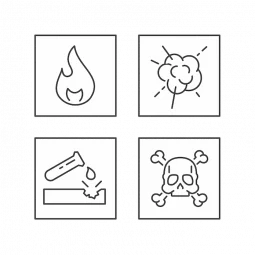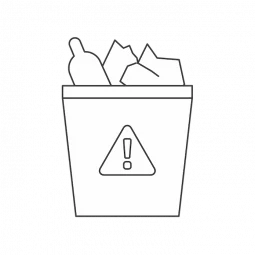There are a range of exposure hazards, including chemical burns, respiratory toxicity, and potential for long-term diseases like cancer and organ failure.
Hazardous waste describes waste products from industrial environments or health services that are toxic, flammable, explosive, oxidizing, corrosive, infectious, or otherwise harmful either to human health or to the environment. This may include asbestos, medical waste, chemicals, oils, contaminated soil, and electrical equipment.
Estimates suggest over 400 million tons of hazardous waste are produced globally every year. The top three industries responsible for producing hazardous waste are thought to be:
The Chemical Industry: Manufacturing a huge range of chemicals used in many products, and often derived ultimately from crude oil, chemical production produces large amounts of various types of hazardous waste.
Paint Manufacturing: Heavy metals and solvents used in the production of paints can be extremely harmful to the environment.
Paper Manufacturing: The processing of wood into paper involves multiple harmful chemicals. In many cases, management of hazardous waste including collection, transport, and processing is outsourced by businesses to specialist companies.
The US Environmental Protection Agency (EPA) classifies four types of hazardous waste: Listed, Characteristic, Universal, and Mixed.




Listed Waste: A specific list of identified waste types. These are sub-divided according to four principles:
Characteristic Waste: Waste identified by its characteristics. Sorted by four main criteria: ignitability, corrosivity, reactivity (i.e. potentially explosive), and toxicity.
Universal Waste: Waste consisting of common products and chemicals that can be harmful to the environment. These include lightbulbs, batteries, explosives, toxic and infectious waste, radioactive waste and other miscellaneous substances and items.
Mixed Waste: Waste containing both hazardous materials and radioactive components. These can be:
* Transuranic elements are chemical elements with atomic numbers greater than 92 (the atomic number of uranium). They are unstable and decay radioactively

Dealing with hazardous waste consists of four key processes: collection, transport, treatment, and sorting. While the first stage of any safety policy should be to engineer systems that remove the risk of contact with hazardous materials, in many cases, at any of these stages workers may need suitable PPE including protective clothing.
In selection of PPE for hazardous waste protection, it is important to understand what the waste is (if possible) and to establish its characteristics and how it might cause harm: Is it likely to ignite or explode? Is it toxic?
Given the wide variety of potential hazardous waste types and characteristics, selection of suitable protective clothing can only be made following a risk assessment.
Because of the range of different application-specific hazards involved, it is impossible to specify garments for use to protect against hazardous waste generally. Each application must be considered on a case-by-case basis.
However, in general terms:
For low hazard risks – light liquid sprays and dusts, disposable suits (EN Types 5 & 6 or OSHA Protection level C) may be suitable. These are lighter-weight fabrics and featuring some level of air-permeability.
For higher hazard risks – liquid chemical splash and sprays require EN Type 3 or 4 or OSHA protection level B suits. These feature barrier fabrics and generally include sealed seams. I key issue is ensuring permeation resistance against the specific chemical.
For very high hazard chemicals, or harmful chemicals that may be in vapor or gas form may need fully integrated gas- tight suits – EN Type 1 or OSHA Protection level B.
Where radioactive waste is involved, stand chemical suits will provide no protection against radiation. Specialist clothing is required. If, however, the need is to prevent contamination dusts that may be contaminated, garments certified to EN 1073-2 should be considered.
Garments must be:
Three factors should be considered:
Garments for managing waste that may contain biological contamination should be certified to European standard EN 14126 or meet the requirements of US test ASTM 1671-13, both of which measure resistance against penetration by infectious agents including blood borne pathogens. EN 14126 also requires certification to one of the EN chemical protective clothing types to ensure garment construction meets the performance required.
In some cases, the exact nature or type of hazard might be uncertain. This could be the case when disposing of soil or waste from old chemical or manufacturing sites where knowledge of chemicals present is limited. Testing can identify the chemicals or hazards, but were there is uncertainty, choosing chemical suits with the broadest possible chemical resistance might be most appropriate.
ChemMax 3, ChemMax 4 Plus, and Interceptor are constructed of high barrier fabric providing protection against a wide range of chemicals.
There are a range of exposure hazards, including chemical burns, respiratory toxicity, and potential for long-term diseases like cancer and organ failure.
Lakeland offers chemical protection in hood, boot, and elastic wrist/ankle configurations for ChemMax 1-3 levels. Apron, sleeves, and boots are offered in ChemMax 1-2 styles. ChemMax 4 Plus offers a respirator hood fit coverall and encapsulated suit. Interceptor Plus suits are offered in totally encapsulating, Level A, vapor protective configurations.
It protects against skin contact and skin absorption of hazardous chemicals, whether it’d be through vapor, liquid, or gas form.
Chemical protective clothing is a garment worn to shield potential threats of chemical hazards that could cause potential injuries to the worker.
Hazardous waste describes waste products from industrial environments or health services that are toxic, flammable, explosive, oxidizing, corrosive, infectious, or otherwise harmful either to human health or to the environment.
Hazardous waste should be stored in a designated storage area that is inaccessible to unauthorized individuals.